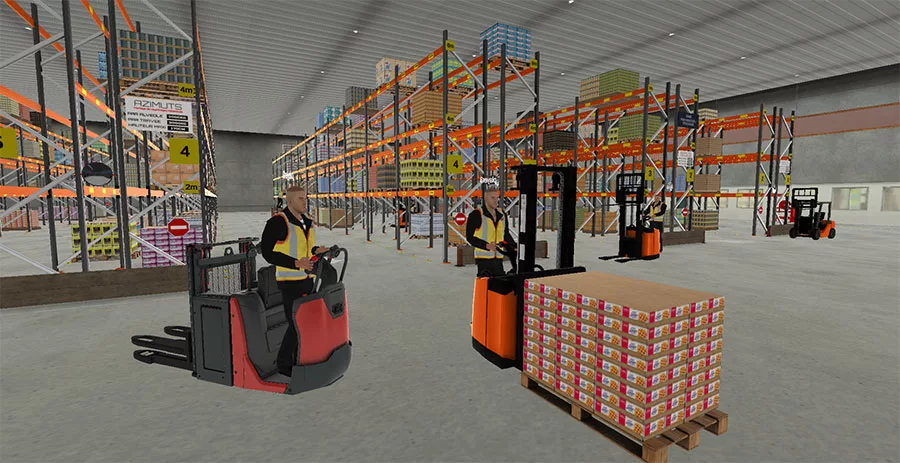The metaverse (or metaverse) is a term used to describe a shared virtual universe. In this environment, users can interact with each other or with the environment in real time.
Popularized by science fiction works and more recently by Mark Zuckerberg, the concept of the metaverse is increasingly being used in real-world applications, including immersive learning, collaborative work, online commerce, and entertainment. The metaverse is an innovation made possible by the software and hardware advancements in virtual reality and online multiplayer virtual world simulation technologies. If yesterday it seemed utopian, today it is a concrete and mature technology.
The term “metaverse” is often associated with the notion of persistence, meaning that it exists and evolves continuously, even when the user is disconnected. Its second characteristic is its accessibility to a large number of users in real time. However, it is commonly used to refer to all multi-user experiences in virtual reality. Thus, for immersive learning, we can benefit from the advantages of the metaverse while retaining the functionalities of training tracking (scenario-based structure, learner progress tracking, etc.). Adapted to training, it becomes a powerful tool with which it is possible to create progressive learning through scenarios, track learners’ progress, and promote co-activity.
State of the art
The metaverse is a rapidly expanding field of research and development. It offers numerous possibilities for learning, including multi-user collaboration in a shared virtual environment. As early as 2016, a study by Morgan Le Chenechal highlighted what the metaverse enables: a complete immersion in a collaborative virtual environment that provides learners, whether remote or in the same location, with a shared, rich, and safe learning space.
However, there is currently no ready-made application for creating, deploying, and maintaining a pedagogical metaverse, as highlighted by Mar Gonzalez-Franco in her 2015 scientific publication. Customized creation that addresses specific needs is therefore necessary.
Several works have also been the subject of scientific publications in the field of industrial design. Whether it is about bringing together domain experts from different specialties or organizing collaborative design meetings, virtual reality is emerging as a preferred tool in the industry to complement computer-aided design.
Metaverse and immersive learning
In the context of immersive learning, the addition of multi-user functionality offers new possibilities to simulation
- Collaboration: The main advantage for immersive learning is the ability to have learners work together within the simulation. In learning, certain activities require the involvement of multiple operators. Until recently, this required integrating non-player characters into the simulation, with whom interactions were more limited. In a multi-user training, each participant can be assigned a role. It then becomes easy to imagine reproducing a virtual production line. Each learner has a specific role in it, and the work of each individual affects that of others.
- Social interactions: The ability for learners to interact with each other helps foster their engagement and motivation. This provides them with the opportunity to help each other in acquiring new skills.
- Training multiple learners simultaneously: Unlike an application dedicated to a single learner, multi-user immersion allows for parallel training of multiple individuals at the same time, saving time for the instructor (who can also organize challenges among these learners!).
- Remote learning: Provided they have access to the necessary equipment (headset and internet connection), users can connect remotely to the application. Learners and the instructor can share the same experience even if they are located in different parts of the world, without the need for travel.
Difficulties to overcome
- Hardware architecture (the set of hardware devices that need to be put in place for the application to work): it involves establishing communication between VR headsets through a server while maintaining a smooth experience. Quality and bandwidth of the internet connection must be ensured if users are connected remotely. For online simulations involving a large number of users simultaneously, the server architecture needs to be adapted (number of simultaneous connections, optimized for parallelization, machine fleet, etc.).
- Software architecture and server load optimization: The networked application requires constant communication between users and the server that processes the data. To achieve this, it is necessary to minimize data transfers to prevent the server from being overloaded with processing tasks and ensure satisfactory response times for users. The increase in the number of participants should not compromise the quality of the experience.
- Maintenance: The multiplication of usage sites and devices (multiple headsets, network connection, one or more servers) inevitably leads to an increased need for hardware maintenance. As a result, it can be useful to implement additional tools to facilitate this maintenance (fleet management tools for headsets and servers, for example).
- Communication for collaboration in VR: Since users can collaborate remotely, it is important to ensure good verbal communication (using integrated voice microphones) as well as non-verbal communication. Other users are represented by an avatar in the simulation, which can be animated using motion capture technology. This allows for more natural and fluid movements from the users. In addition to the head and hand position (captured through the headset and controllers), some devices also enable the capture of the user’s facial expressions.
- Performance is crucial to ensure the simultaneity of operations, as maintaining low latency is essential to avoid desynchronization and maintain the consistency of actions. For instance, when a user interacts with an object, it should move/react in the same way in the environments of other users. Given that each user can interact with objects, if two users perform the same action simultaneously, the server must assign priorities to determine which interaction to allow.
- Access to relevant information streams by the instructor: a large amount of information is transmitted through the server. The instructor should be able to access real-time filtered, useful, and relevant information for their pedagogical activities. To ensure effective training monitoring, it is necessary to track the learners’ position in the 3D space as well as their progress in the training scenario.
- Accessibility for users: Since virtual reality is not yet widely used by the general public, this type of application is sometimes the first VR experience for a learner. Therefore, a user may require assistance from the instructor. For example, users may need assistance with hardware setup (properly fitting the headset, configuring the environment, etc.) or with simulation controls (how to move, interact with objects, etc.).
Experiences already very real
Pioneer of Immersive Learning, Audace has already designed several projects of multi-user virtual reality simulations. Here are two examples:
Project “Halle 4.0” – AFTRAL
In “Halle 4.0,” learners (1 to 3 per session) are immersed in a logistics hall where they play the role of versatile logistics operators. Depending on the scenarios, they either compete against each other or, on the contrary, need to cooperate to accomplish their mission.
Learners can explore various positions such as reception, shipping, order preparation, packaging, and parcel storage and retrieval. They are also trained on best practices for operating carts and safety precautions.
“Decontamination Pool” Project – Orano
Audace developed a virtual reality simulator at the request of Orano to train operators in nuclear pool decontamination interventions. The simulator includes the possibility for two learners to perform certain decontamination operations in the same environment.
The system allows for training of operators outside of the real context, which is inaccessible for training purposes. In a hyper-realistic immersion, technicians can repeat technical gestures as many times as needed and work on their coordination until they are fully operational.
Conclusion
Research and innovation in metaverse technologies have made it more mature and viable in the field of education and training.
The metaverse offers promising prospects for immersive learning by enabling complete immersion in a collaborative virtual environment. Learners can interact in real time, collaborate, and benefit from a rich and safe learning environment. However, there are still challenges to overcome, including the accessibility of the technology, hardware and software constraints, as well as the evaluation of acquired skills. In the field of professional training, the potential of the metaverse remains immense.

